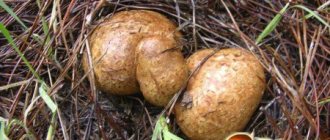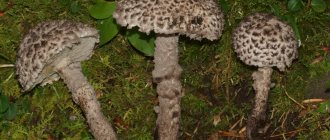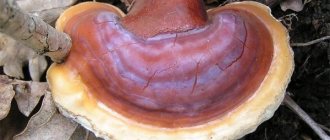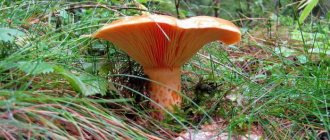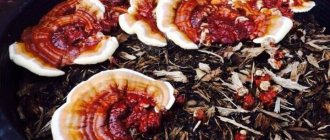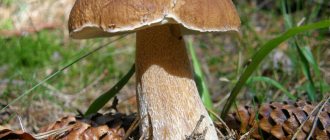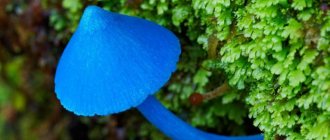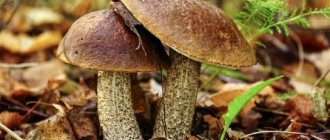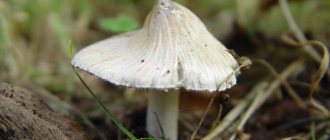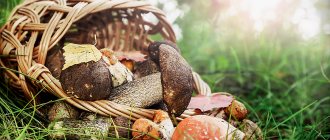Short description
| Type of mushrooms: | Inedible |
| Other names (synonyms): | Ganoderma oleoresin, Ashtray, Lingzhi |
| Latin name: | Ganoderma resinaceum |
| Family: | Ganodermataceae |
| Distinctive feature: | Ganoderma resinous is a rare porous fungus that persists throughout the year. As the fruiting body grows, this beautiful fungus turns black and can be mistaken for the Fomes fomentarius fungus. |
| Beginning of the season: | January |
| End of season: | December |
| Leg height (cm): | – |
| Cap width (cm): | 15-35 x 10-20 cm |
| Smell: | pleasant, spicy |
| Taste: | not typical |
| Tasting score: | – |
| Hat: | flat, cork or woody in structure. The color of young mushrooms is reddish, shiny; in adulthood, the color of the cap changes, it becomes brick, brown, and then almost black and matte. The edges are grayish, with an ocher tint. |
| Leg: | absent |
| Hymenophore (bottom of cap): | the brown tubes are 8 to 20 mm deep and they end in rounded pores. |
| Disputes: | wide elliptical, 10-12 (13) x 7-9 microns |
| Pulp: | soft, very similar in structure to cork; in young mushrooms it is grayish, and then changes color to red and brown. |
| Natural environment and mycorrhiza: | parasitizes on living tree trunks, especially oaks and beeches. |
| False doubles: |
|
| Growing: | – |
| Use: | – |
| Medicinal properties: | – |
| Spreading: | in some northern and central parts of continental Europe, North Africa, Asia, Australia and South and North America. |
Lingzhi are mushrooms of immortality, this is exactly what Chinese healers believe, classifying this mushroom as a wonder of nature. The Japanese call this species “rei-shi” (reishi) and “mannentake” (translated as ten-thousand-year-old mushroom) and classify it as a plant of spiritual power.
Based on this fruiting body, tinctures and extracts are prepared, it is grown and harvested. Find out everything about the healing properties of the miracle mushroom “ling zhi”, how to take it correctly, and in what form. What do you need to know about the strange fruit?
Description of the mushroom
The mysterious mushroom of immortality also has quite earthly names: Reishi, Lacquered tinder fungus, Ganoderma resinous, Ganoderma oleoresin, Ashtray mushroom. Belongs to the species Lacquered polypore, genus Ganoderma, family Polyporaceae. In Latin, its name looks like this: Ganoderma resinaceum.
Most often, the fruiting body of the varnished tinder fungus consists only of a cap; less often, it also has a sharp stalk. The hats are flat, woody, and cork. Their diameter can be from 40 to 45 cm. The skin is very smooth, shiny, uneven, divided into many growth rings, each of which has a certain shade.
Young specimens are characterized by a reddish color, later it darkens to brown or brick, and in adult fruits it becomes black. The edges are grayish, with an ocher tint.
The hymenophore (lower part of the cap) is tubular-type, has small and round pores, the tubes are short, ocher, and arranged in one layer. The spores are slightly truncated at the top and covered with a two-layer membrane. The color of the spores is brown.
The structure of the pulp resembles a cork; it is dense and grayish. It has no smell or taste.
The leg reaches from 5 to 25 cm in length, its diameter is 1–3 cm. The shape is cylindrical, uneven and very dense.
The varnished tinder fungus is listed in the Red Book of Russia as a rare species.
A little history
Lingzhi was first described by the Austrian botanist Nikolaus Jacquen in 1821, giving it the name Boletus rugosus. Later, many other scientists studied this species, but the modern name Ganoderma lucidum was given to the lacquered polypore by the “father of Finnish mycology” Peter Adolf Karsten in 1881.
Varieties
Chinese healers have long divided numerous local varieties of reishi according to the therapeutic effect they provide:
- Dragon mushroom, green in color - sour in taste - grows on the sacred mountain of Tianshan, heals the liver and symbolizes the tree.
- Red, bitter in taste - grows on Mount Hengshan, heals the heart and symbolizes fire.
- Yellow, sweet in taste. Grows on Songshan Mountain, heals the spleen and symbolizes the soil.
- Jasper is white, pungent in taste, grows on Mount Huashan, heals the lungs and symbolizes metal.
- Black, has a salty taste, grows on Mount Changshan and symbolizes water.
- Menthol, neutral in taste, grows everywhere and gives the skin eternal youth.
Time and place of fruiting
The Ashtray mushroom is quite common in the world, but in our area it grows extremely rarely. Resinous Ganoderma is found in the Far East, Altai, Carpathians and the Caucasus. Habitat: coniferous forests with a predominance of sequoia. Lingzhi often grows on willow, beech, alder, and oak.
Fruiting time is from June to late autumn.
Reference! Reishi is very rarely found in the wild, so it was once considered a product of aristocrats and emperors.
Growing at home and in the country
Cultivating medicinal lingzhi mushrooms at home is not difficult. Another important fact is that from one mycelium you can get a harvest for 4–5 years, which is also very profitable.
For example, the cheapest place to buy tinder fungus is in Asian countries - China, Thailand and Vietnam. In Russia, capsules in a box cost more than one thousand rubles, while in Thailand such a box will cost about 200 baht.
There are several ways to breed Ganoderma: growing on stumps, cultivating on sawdust and in vitro.
How to grow lingzhi on stumps:
- Prepare the stumps of deciduous and fruit trees (coniferous trees are not suitable), mycelium, substrate, and a place for future planting. It would be optimal to place the mycelium away from sunlight, in an area with high humidity.
- Prepare the soil for saprophytes (stumps on which future tinder fungi will grow). To do this, you need to prepare a special soil from 5 parts peat, 1 part limestone and 4 parts soil. You can supplement the substrate with straw or manure.
- The above components must be thoroughly mixed and fertilized in the stump hole. After planting the tree, you need to cover it with substrate around its entire circumference.
- Using a drill, make holes in the wood with a depth of 7 and a diameter of 1.2 cm. Insert special wooden sticks with mycelium into them.
- Cover the clearing with film. The temperature in the area must be maintained at 20–26 ºС at all times. During the cold season, you can move the stumps to a warm room.
Important! The more sticks with mycelium placed on the wood, the greater the harvest.
How to grow lingzhi on sawdust:
- Prepare a substrate from the following components: 80% sawdust with 20% additional nutrient mixtures (oatmeal, barley husks, minerals).
- Mix the mixture thoroughly and moisten it slightly.
- Place the substrate in a container and fill it with mycelium.
- Sprinkle the mycelium with soil. It will take 15–20 days for the fruiting bodies to germinate.
- During this period, it is very important to maintain an optimal humidity level: at least 75%. The room temperature should not fall below 18 ºС.
- As soon as mycelium appears on the surface of the sawdust, you need to make cuts in the bags. This will not only help the mushrooms germinate faster, but will also ensure normal access of oxygen to the fruiting bodies.
Reference! This cultivation method allows you to get a harvest faster, but its technology requires increased attention and care.
How to prepare an infusion
If dried lingzhi is purchased whole, and there is not enough time to brew according to the recipe, it must be wrapped in food or placed in a container to prevent access to fresh air. Place in a dry, dark place, but not in the refrigerator.
To properly prepare the alcohol extract, grind the mushroom plates or chop the dried ganoderma - very thin slices are suitable for easy extraction.
Method of preparation recommended by Vietnamese herbalists:
- Take 500 g of dry chopped raw materials; you can use whole reishi if the impregnation takes place for 4-5 weeks or longer.
- Pour 5 liters of 40% alcohol; if the liquid does not completely cover the mushroom chips, place a heavy glass or ceramic object on top. Close tightly and place in a cool, dark room.
- Shake the contents daily to better extract valuable substances.
- After 6 weeks, you can strain the extract through a fine sieve.
During the infusion period, the mushroom cap absorbs a lot of liquid and swells. In order not to throw away the healing extract, all moisture should be squeezed out of the product.
The standard method of use is to mix the tincture 1:2 with water, drink half an hour before meals, twice a day. It is advisable to take the morning dose on an empty stomach. A similar method is used to prepare an extract from cordyceps.
Medicinal properties
The benefits of Ganoderma oleoresin are truly enormous. The fruiting body contains unique substances and components:
- germanium. The trace element increases the concentration of oxygen in the blood, increases metabolism, and helps control free radicals.
- polysaccharides. They help cleanse the body of toxins, strengthen the immune system, and balance blood sugar.
- ganoderma essence. Has wound healing properties.
- triterpenoid. Relieves pain, promotes weight loss, has anti-allergenic qualities.
- adenosine Reduces cholesterol concentration, regulates metabolism, prevents blood clots.
The healing properties of reishi are manifested in the following:
- prevention of cancer;
- normalization of the cardiovascular system;
- treatment of lung pathologies;
- elimination of bacterial infections;
- treatment of osteoporosis;
- calming effect on the nervous system;
- migraine treatment;
- fight against Alzheimer's disease;
- treatment of symptoms of depression;
- normalization of memory (lingzhi-based products are used for accompanying treatment of Parkinson's disease).
Reference! The most valuable are the reishi collected on Mount Tianshan. It is believed that reishi grows on an old rotten tree, the energy of which is consumed. The mushroom absorbs everything immortal that remains after the plant rots, and the roots of lingzhi, reaching the ground, absorb useful minerals.
Application of lingzhi in cosmetology
A decoction of the lacquered tinder fungus is used as the main component of face masks. The rejuvenating effect of tinder fungus is widely known as part of the cosmetic line “Lingzhi and Biogold”, produced by Thai pharmacists.
It has a wonderful effect on hair, improving its growth and strengthening it. In Thailand they even produce special shampoos and balms based on lingzhi extract.
To prepare a reishi face mask, you need to mix 3 tablespoons of dried mushroom powder, add a spoonful of sour cream and a couple of drops of olive oil. Mix everything well and apply to the face. After 20 minutes, wash off the composition and rinse your face with cool water. This product promotes skin rejuvenation, nourishes and moisturizes it.
You can also make a mask from the tincture. To do this, you need to mix half a teaspoon of the drug, add 10 drops of vitamin E, 1 tablespoon of aloe juice, 5 drops of olive oil. The product is applied to the skin of the face and neck and washed off after 20 minutes.
Medicinal uses of reishi
The real tinder fungus is the object of study by many scientists from Canada, Japan, France and China. Its healing properties are especially interesting from the point of view of treating cancer: reishu is being actively studied in many countries around the world, and they are also trying to determine whether it helps in the prevention of cancer.
However, global medical attention has been paid to the fungus only recently. But even during this time, some areas of health have found great benefits from this variety of mushrooms:
- helps with diseases of the heart and blood vessels, restores blood pressure balance;
- included in herbal medicines for the treatment of diabetes;
- restores the nervous system, helps fight overexcitability, drowsiness and apathy;
- helps fight swelling, is used in weight loss diets;
- suppresses inflammatory processes caused by infections of the respiratory tract and gastrointestinal tract;
- stimulates the production of immune antibodies, helps fight allergies.
The mushroom has a complex strengthening effect, restores ability to work and does this without harm to other organs.
Doctors use lingzhi to prevent oncology, believing that the mushroom slows down the development of tumors and metastases, suppresses allergies and strengthens the immune system, helping the body fight malignant processes.
Contraindications
It is worth paying attention to the fact that only reishi grown in the wild has the entire list of beneficial qualities. Ganoderma, cultivated artificially, is characterized only by general strengthening properties.
Preparations created on its basis saturate the body with useful microelements, valuable substances, but more. The natural drug can only be purchased in pharmacies; the manufacturers must be listed as China or Thailand.
The main contraindications are: age under 12 years, pregnancy and lactation, and individual intolerance.
Who shouldn't drink
In reasonable dosages, you can safely consume reishi mushrooms without fear of side effects. However, people who are sensitive to some components may experience minor digestive upsets and skin irritations, which immediately disappear after stopping use.
A number of studies have been conducted which have shown that this product is safe and well tolerated by the vast majority of people, however, it is recommended to talk to a specialist or doctor before starting use. There is a recommendation - to use the mushroom for no longer than 1 year, and then take a break.
Side effects are very rare. But if you have a dry mouth, an unpleasantly itchy nose, gastrointestinal problems, skin irritations and rashes, nosebleeds or bloody stool, stop taking Reishi and consult a doctor immediately.
There are restrictions for pregnant women and young mothers who are breastfeeding - the effects of mushrooms on the body have not been studied, so it is better to exclude them from your diet for this period. It is also worth limiting your consumption 2-3 months before planning a pregnancy. Reishi is not recommended for use by children under one year of age.
There are strict contraindications:
- Have problems with blood clotting
- Postoperative period
- Taking medications to lower blood pressure
- Taking medications that thin the blood
- Undergoing chemotherapy
- Taking immunosuppressants
The fact is that reishi mushrooms can affect blood pressure and increase the risk of bleeding.
Video gallery
Video reviews
A selection of videos with descriptions and recipes for preparing mushrooms
Sergey Zhigalov, Beaver Stream Jet-Life, New business ideas
Chemical composition
The medicinal properties of this mushroom are due to its very specific composition, which is presented:
- water – 92 g;
- proteins – 3 g;
- fats – 0.3 g;
- inorganic substances – 0.85 g;
- carbohydrates – 3.3 g;
- fiber – 1.0 g;
- total sugars – 2 g.
Average mineral content:
- calcium – 3 mg;
- iron – 0.5 mg;
- magnesium – 9 mg;
- phosphorus – 86 mg;
- potassium – 318 mg;
- sodium – 5 mg;
- zinc – 0.52 mg;
- copper – 0.32 mg;
- manganese – 0.047 mg;
- selenium – 9.3 mcg.
The pulp of the mushroom contains sufficient amounts of vitamin C, thiamine, riboflavin, nicotinic and pantothenic acid, vitamins B6 and B12, folate, folic acid, choline, betaine, alpha-tocopherol and vitamins D and K.
100 grams of tinder fungus contains approximately 21-23 kcal.
